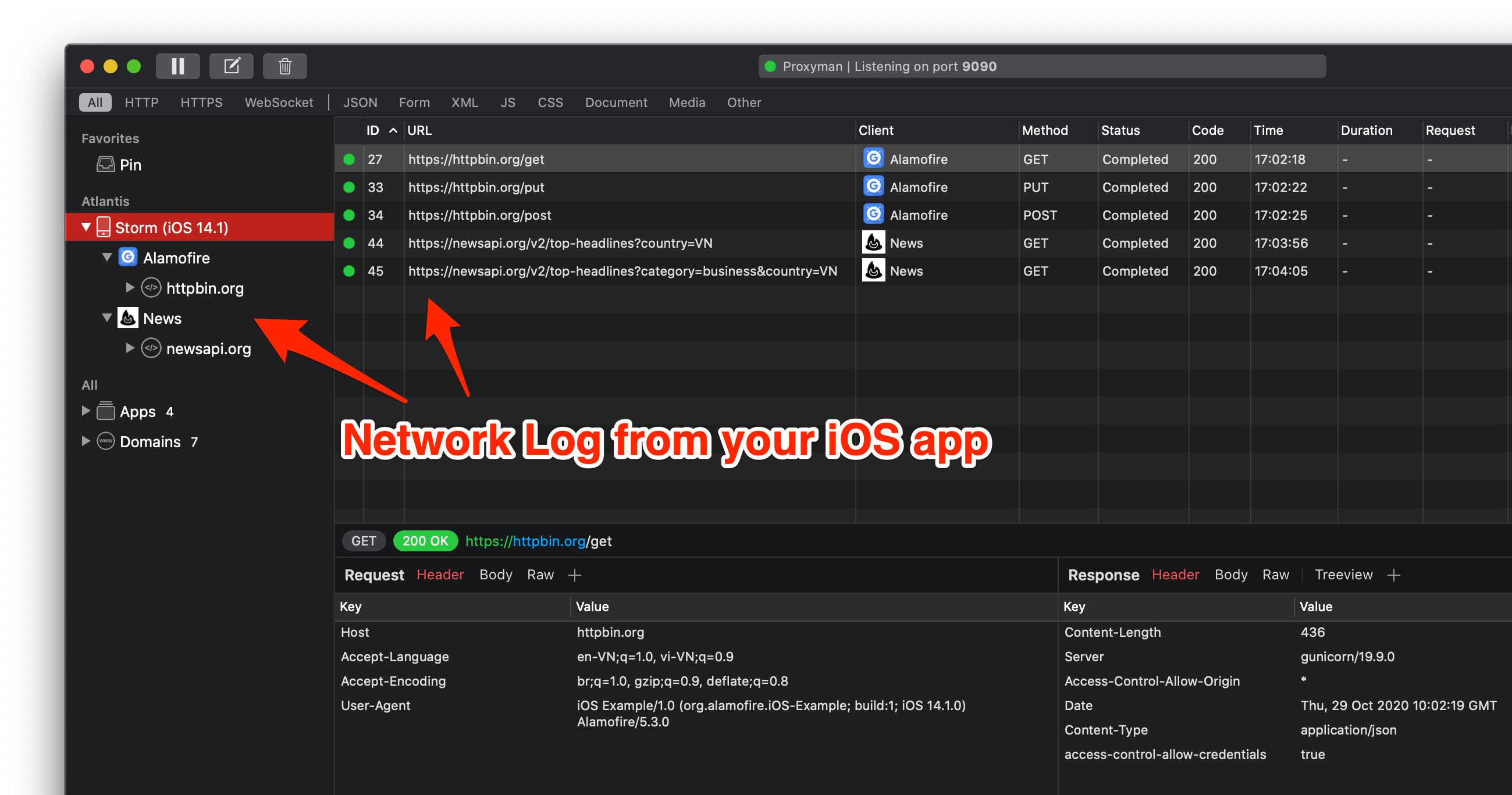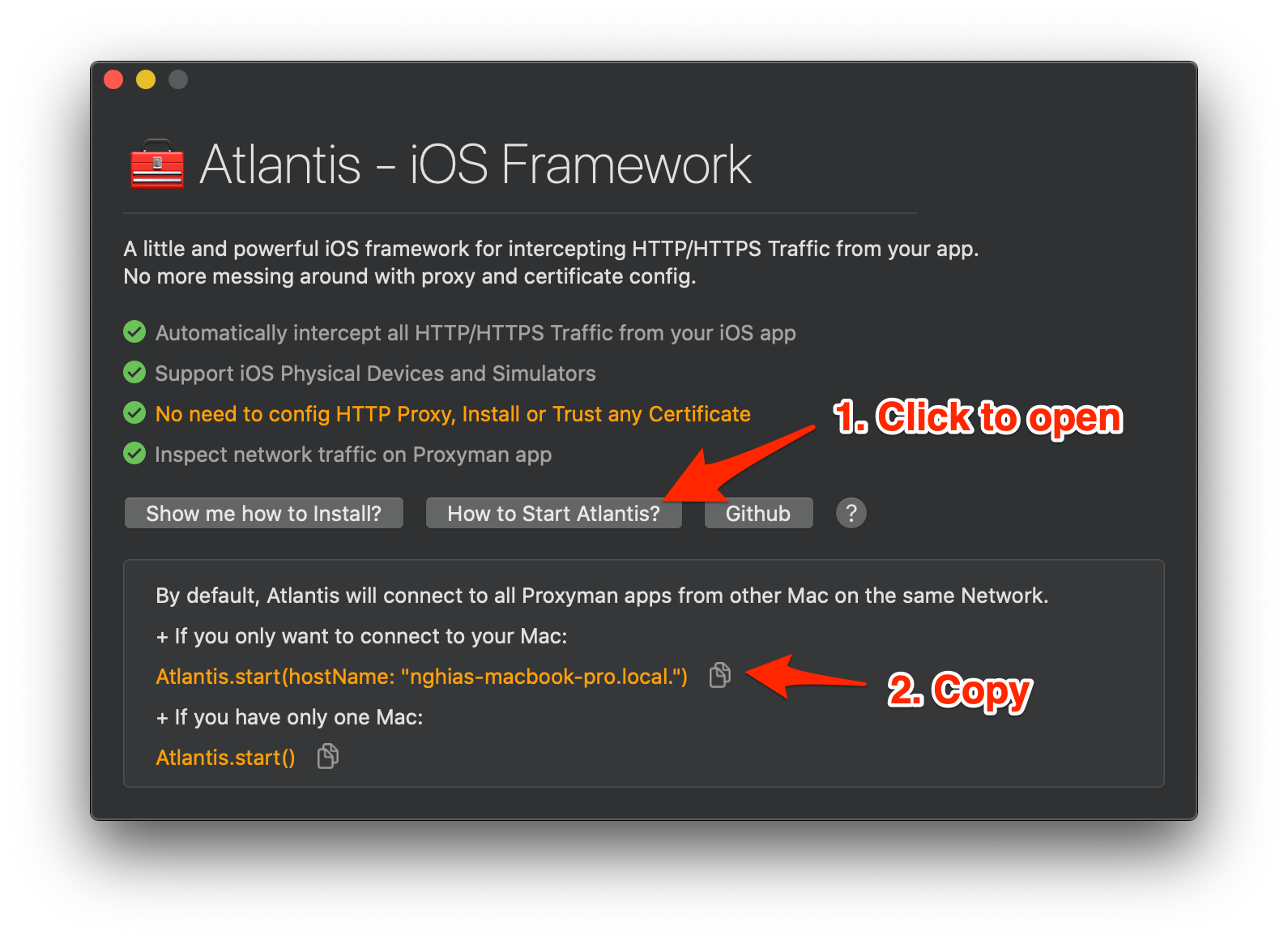A little and powerful iOS framework for intercepting HTTP/HTTPS Traffic from your app. No more messing around with proxy, certificate config.
Features
- Automatically intercept all HTTP/HTTPS Traffic with ease
- Capture WS/WSS Traffic from URLSessionWebSocketTask
-
✅ No need to config HTTP Proxy, Install or Trust any Certificate - Support iOS Physical Devices and Simulators
- Review traffic log from macOS Proxyman app (Github)
- Categorize the log by project and devices.
- Only for Traffic Inspector, not for Debugging Tools
- Ready for Production
How to use
- Install Atlantis by CocoaPod or SPM, then starting Atlantis
By default, Bonjour service will try to connect all Proxyman app in the same network:
- If you have only ONE MacOS machine that has Proxyman. Let use the simple version:
import Atlantis
// Add to the end of `application(_:didFinishLaunchingWithOptions:)` in AppDelegate.swift or SceneDelegate.swift
Atlantis.start()
- If there are many Proxyman apps from colleague's Mac Machines, and you would Atlantis connects to your macOS machine. Let use
Atlantis.start(hostName:)version
import Atlantis
// Add to the end of `application(_:didFinishLaunchingWithOptions:)` in AppDelegate.swift or SceneDelegate.swift
Atlantis.start(hostName: "_your_host_name")
You can get the hostName from Proxyman -> Certificate menu -> Install for iOS -> Atlantis -> How to Start Atlantis -> and copy the HostName
- If your project uses Objective-C
#import "Atlantis-Swift.h"
// Add to the end of `application(_:didFinishLaunchingWithOptions:)` in AppDelegate
[Atlantis startWithHostName:nil];
- Make sure your iOS devices/simulator and macOS Proxyman are in the same Wifi Network or connect your iOS Devices to Mac by a USB cable
- Open macOS Proxyman (or download the lasted here) (Github)(2.11.0+)
- Open your iOS app and Inspect traffic logs from Proxyman app
- Enjoy debugging
❤️
Requirement
- macOS Proxyman app 2.11.0+
- iOS 11.0+ / macOS 10.12+ / Mac Catalyst 11.0+
- Xcode 11+
- Swift 5.0+
Required Configuration for iOS 14+
From iOS 14, it's required to add NSLocalNetworkUsageDescription and NSBonjourServices to your info.plist
- Open Info.plist file and adding the following keys and values:
<key>NSLocalNetworkUsageDescriptionkey>
<string>Atlantis would use Bonjour Service to discover Proxyman app from your local network.string>
<key>NSBonjourServiceskey>
<array>
<string>_Proxyman._tcpstring>
array>
Install
CocoaPod
- Add the following line to your Podfile
pod 'atlantis-proxyman'
Swift Packages Manager
- Add
https://github.com/ProxymanApp/atlantisto your project by: Open Xcode -> File Menu -> Swift Packages -> Add Package Dependency...
Carthage
- Add to your Cartfile
github "ProxymanApp/atlantis"
- Run
carthage update - Drag Atlantis.framework from your project
- Create a Carthage Script as the Carthage guideline
For Carthage with Xcode 12, please check out the workaround: https://github.com/Carthage/Carthage/blob/master/Documentation/Xcode12Workaround.md
WS/WSS Traffic
From Atlantis 1.9.0+, Atlantis is capable of capturing all WS/WSS Traffic, which is made by URLSessionWebSocketTask, and send to Proxyman app. You don't need to config anything, it works out of the box.
Advanced Usage
By default, if your iOS app uses Apple's Networking classes (e.g URLSession or NSURLConnection) or using popular Networking libraries (e.g Alamofire and AFNetworking) to make an HTTP Request, Atlantis will work OUT OF THE BOX.
However, if your app doesn't use any one of them, Atlantis is not able to automatically capture the network traffic.
To resolve it, Atlantis offers certain functions to help you manually* add your Request and Response that will present on the Proxyman app as usual.
1. My app uses C++ Network library and doesn't use URLSession, NSURLSession or any iOS Networking library
You can construct the Request and Response for Atlantis from the following func
/// Handy func to manually add Atlantis' Request & Response, then sending to Proxyman for inspecting
/// It's useful if your Request & Response are not URLRequest and URLResponse
/// - Parameters:
/// - request: Atlantis' request model
/// - response: Atlantis' response model
/// - responseBody: The body data of the response
public class func add(request: Request,
response: Response,
responseBody: Data?) {
- Example:
@IBAction func getManualBtnOnClick(_ sender: Any) {
// Init Request and Response
let header = Header(key: "X-Data", value: "Atlantis")
let jsonType = Header(key: "Content-Type", value: "application/json")
let jsonObj: [String: Any] = ["country": "Singapore"]
let data = try! JSONSerialization.data(withJSONObject: jsonObj, options: [])
let request = Request(url: "https://proxyman.io/get/data", method: "GET", headers: [header, jsonType], body: data)
let response = Response(statusCode: 200, headers: [Header(key: "X-Response", value: "Internal Error server"), jsonType])
let responseObj: [String: Any] = ["error_response": "Not FOund"]
let responseData = try! JSONSerialization.data(withJSONObject: responseObj, options: [])
// Add to Atlantis and show it on Proxyman app
Atlantis.add(request: request, response: response, responseBody: responseData)
}
2. My app use GRPC
You can construct the Request and Response from GRPC models:
/// Helper func to convert GRPC message to Atlantis format that could show on Proxyman app as a HTTP Message
/// - Parameters:
/// - url: The url of the grpc message to distinguish each message
/// - requestObject: Request Data for the Request, use `try? request.jsonUTF8Data()` for this.
/// - responseObject: Response object for the Response, use `try? response.jsonUTF8Data()` for this.
/// - success: success state. Get from `CallResult.success`
/// - statusCode: statusCode state. Get from `CallResult.statusCode`
/// - statusMessage: statusMessage state. Get from `CallResult.statusMessage`
public class func addGRPC(url: String,
requestObject: Data?,
responseObject: Data?,
success: Bool,
statusCode: Int,
statusMessage: String?,
HPACKHeadersRequest: [Header]?,
HPACKHeadersResponse: [Header]?){
- Example:
// Your GRPC services that is generated from SwiftGRPC
private let client = NoteServiceServiceClient.init(address: "127.0.0.1:50051", secure: false)
// Note is a struct that is generated from a protobuf file
func insertNote(note: Note, completion: @escaping(Note?, CallResult?) -> Void) {
_ = try? client.insert(note, completion: { (createdNote, result) in
// Add to atlantis and show it on Proxyman app
Atlantis.addGRPC(url: "https://my-server.com/grpc",
requestObject: try? note.jsonUTF8Data(),
responseObject: try? createdNote.jsonUTF8Data(),
success: result.success,
statusCode: result.statusCode.rawValue,
statusMessage: result.statusMessage)
})
}
FAQ
1. How does Atlantis work?
Atlantis uses Method Swizzling technique to swizzle certain functions of NSURLSession and NSURLConnection that enables Atlantis captures HTTP/HTTPS traffic on the fly.
Then it sends to Proxyman app for inspecting later.
2. How can Atlantis stream the data to the Proxyman app?
As soon as your iOS app (Atlantis is enabled) and the Proxyman macOS app are the same local network, Atlantis could discover the Proxyman app by using Bonjour Service. After the connection is established, Atlantis will send the data via Socket.
3. Is it safe to send my network traffic logs to the Proxyman app?
It's completely safe since your data is locally transferred between your iOS app and the Proxyman app, no Internet is required. All traffic logs are captures and send to the Proxyman app for inspecting on the fly.
Atlantis and Proxyman app do not store any of your data on any server.
4. What kind of data that Atlantis capture?
- All HTTP/HTTPS traffic from your iOS apps, that integrate the Atlantis framework
- Your iOS app name, bundle identifier, and small size of the logo
- iOS devices/simulators name and device models.
All the above data are not stored anywhere (except in the memory). It will be wiped out as soon as you close the app.
They are required to categorize the traffic on the Proxyman app by project and device name. Therefore, it's easier to know where the request/response comes from.
Troubleshooting
1. I could not see any request from Atlantis on Proxyman app?
For some reason, Bonjour service might not be able to find Proxyman app.
=> Make sure your iOS devices and the Mac are in the same Wifi Network or connect to your Mac with USB Cable
=> Please use Atlantis.start(hostName: "_your_host_name") version to explicitly tell Atlantis connect to your Mac.
2. I could not use Debugging Tools on Atlantis's requests?
Atlantis is built for inspecting the Network, not debugging purpose. If you would like to use Debugging Tools, please consider using normal HTTP Proxy
Credit
- FLEX and maintainer team: https://github.com/FLEXTool/FLEX
- @yagiz from Bagel project: https://github.com/yagiz/Bagel
License
Atlantis is released under the Apache-2.0 License. See LICENSE for details.










 Just see the two requests, with IDs ordered the same as their timestamps, which is what I'd hope for as this is the reality
Just see the two requests, with IDs ordered the same as their timestamps, which is what I'd hope for as this is the reality See four requests, with IDs that don't match the order of the timestamps. This obviously makes it hard to look at exported network logs and make sense of what was really going on.
See four requests, with IDs that don't match the order of the timestamps. This obviously makes it hard to look at exported network logs and make sense of what was really going on.


